 PzKpfw VI Tiger I, or SdKfz 181. |
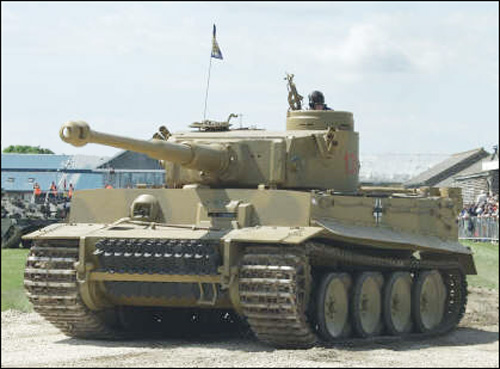 |
| Weighing 56 tons of the best quality German rolled homogeneous nickel-steel plate armor, and carrying the dreaded 88 mm KwK 36L/56 high-velocity gun, the Tiger I was designed to dominate the battlefield. |
Introduction
Despite the decision to mass produce the PzKpfw III and IV, and the far certainty at the time that these two models would be adequate for the expected battles of the future, the German general staff also called for an even heavier tank in 1937. This was to be of 29.53 tons (30,000 kg) or more and was to be a heavy "breakthrough" tank to lead the armored assaults. The design lapsed until 1941, by when it was realized that the PzKpfw III and IV had been less successful than had been expected against the heavily armored French and British tanks in 1940. This view was fully endorsed when the Soviet T-34s and KV-1s were met later in 1941, and resulted in a specification for a heavy tank capable of mounting the highly successful 88 mm high-velocity gun in a turret with full traverse and carrying sufficient armor to defeat all present and future anti-tank weapons. Two firms submitted prototypes, using some of the developments from the 1937 ideas. These were Porsche and Henschel. The turret was common to both and came from Krupp.
The official WaPrüf 6 designation to the Porsche prototype from 5 March 1942 was PzKpfw VI (VK 45.01 P) (Ausfürung P). The Inspekteur der Panzertruppen (In6) designation, specified for use in training and maintenance manuals and in organization tables, was Panzerkampfwagen VI P (88 mm)(SdKfz 181) Ausfürung P. Suggested names were 'Tiger (P)', 'Tiger P1' or 'Porsche Tiger'. The Henschel prototype received the designation VK 45.01 (H). This Henschel model came into being as a rush job, quickly assembled from a mixture of components available from previous heavy panzer designs. Henschel were not originally involved in the 45 metric ton heavy tanks project, as they had been tasked with the development of a 36 metric ton medium tank with 80 mm front armor, the designation of which was Panzerkampfwagen VI Ausfürung B (VK 36.01). To meet the demand that the production program was to start in 1942, the VK 45.01(H) was quickly created by redesigning the VK 36.01. A new feature was the Vorpanzer (frontal shield) which could be lowered to protect the track and drive sprockets. However, this feature was quickly dropped, having only been fitted on this Versuchsserie Tiger Nr. 'V1'.
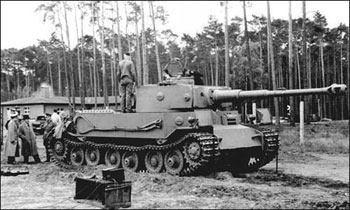
|
 |
| Ferdinand Porsche (with the hat) and the PzKpfw VI VK 45.01(P). | The Henschel prototype - with the Vorpanzer (frontal shield). |
After tests conducted on 20 April 1942, the Henschel prototype was chosen for series production. The decision was based on a maneuverability test, and on the fact that the Henschel prototype was more conventional, cheaper and easier to produce than the extravagant Porsche design. The final prototype almost doubled the initial projected weight. It weighed a full 56 tons of the of the best quality German rolled homogeneous nickel-steel plate armor.
The designation applied by the Inspekteur der Panzertruppen (In6) was originally PzKpfw VI H (88 mm) (SdKfz 182) Ausfürung H1. This name was retained until 5 March 1943 when it was officially changed to Panzerkampfwagen TIGER (88 mm L/56) (Sdkfz 181) Ausfürung E . The name formerly used was 'Tiger H1'.
This suggestive name was finally changed to the familiar TIGER I on 5 March 1943, but both the designation PzKpfw VI and Tiger remained in common usage by the units and operational staffs until the end of the war.
Production began slowly in August 1942. First four Tigers were delivered to the schwere Panzer Abteiling 502 and fought their first battle near Leningrad, on 29 August 1942, and the outcome was not exactly successful for the Tigers. However, the following action reports drew a clear picture of the exceptional weapon the Tiger I was.
At the time of its introduction, and for some time afterwards, the Tiger I was the most powerful tank in the world. The 88 mm KwK L/56 gun, for which the Tiger I had 92 rounds of ammunition, was enormously formidable, and the armor ensured that any frontal shot could not penetrate.
Due to the combination of mobility, protection, and firepower with better optics, the Tiger I could engage, outshoot and outrange almost anything the Allies could put against it, at many times its own numbers, until the introduction of the JS-2 heavy tank by the Russians. As a result, the Allies had to develop special tactics to deal with it. The limited number available for action left an overwhelming impression on their opponents.
In the end, the real failure of the German Tiger tanks was that they exceeded the capabilities of the German industry to produce them in sufficient numbers to make any difference in the big picture, and the maximum degree of success attained by the Tiger units was limited and/or localized tactical superiority.
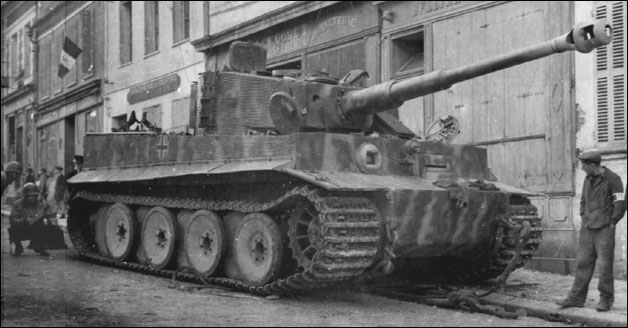
A PzKpkw VI Tiger I, abandoned in France, 1944.
The Tiger I was phased out in 1944. By August of that year 1,349 had been delivered to the Wehrmacht, not many in view of their reputation and effect on Allied morale. Perhaps this is the best epitaph the Tigers could have.
PzKpfw VI Tiger I Menu:
| BROWSE BY SUBJECT: | |
|---|---|
| PROTECTION | FIREPOWER |
| MOBILITY | PRODUCTION |
| SPECIFICATIONS | DOWNLOADS |
| TIGER ART! | |
Bibliography
|
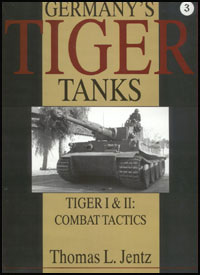
|
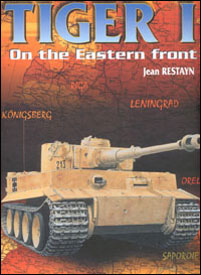 |
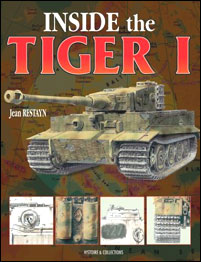 |
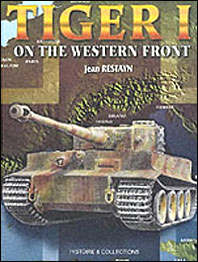 |
You can find Mr Jean Restayn's
books at J.J.Fedorowicz
Publishing, Inc. and
Histoire and Collections:
5, Avenue de la Republique
75541, Paris, cedex 11
FRANCE

Sledgehammers, by Christopher W. Wilbeck.
|
Every bit of information on www.fprado.com/armorsite is for the purpose of information, criticism, comment, news reporting, teaching, scholarship, and/or research. |
The ARMOR Site! is © Copyright 1997-2005 Fabio Prado . All Rights Reserved.

